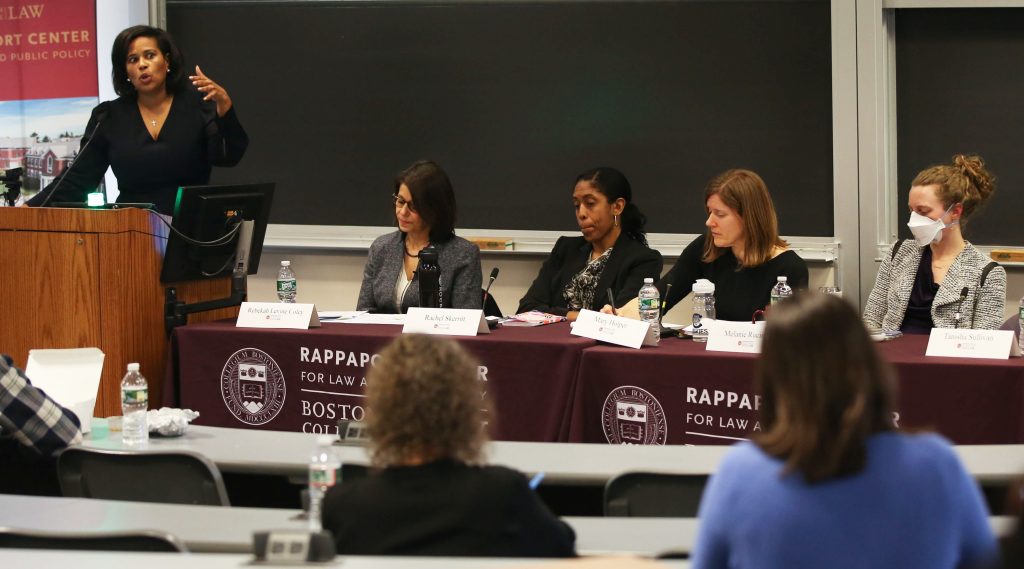Recent developments in the fight for educational equity and opportunity in Boston Public Schools (BPS) was the focus of a recent Rappaport Center for Law and Public Policy panel discussion.
The four-member panel was moderated by BC Lynch School Professor Rebekah Levine Coley, chair of Counseling, Developmental, and Educational Psychology. Levine Coley is also a member of the Rappaport Center Advisory Board..
In 2020, at the height of a global health pandemic, the school district implemented a new interim admission policy for its three “exam schools”—Boston Latin Academy, Boston Latin School, and the John D. O’Bryant School of Mathematics and Science—that require application and testing in order to attend.
Melanie Rucinski, a PhD candidate at the Harvard Kennedy School, spoke about the role she played in jump-starting the reform efforts: In 2018, she and her colleague, Professor Joshua Goodman, published a seminal study which revealed stark racial gaps in exam school admissions. According to their research, Black and Hispanic students made up approximately 75 percent of BPS students, but comprised only 20 percent of students at Boston Latin School, the most selective of the exam schools.
Rucinski theorized that several factors might have contributed to the ongoing inequities: an admissions test that vastly differed from state curricula, testing on weekends when public transit is least reliable, and a pervasive sense in the Black and Hispanic communities that the schools were unfriendly or discriminatory toward them. “No single gap is the most important in driving the overall lack of diversity at these schools,” Rucinski said. “Any successful intervention must address multiple gaps in the pipeline at once.”
Rucinski’s study catalyzed Boston policymakers, including Tanisha Sullivan ’02 and Rachel Skerritt, who both served on the BPS task force entrusted with implementing the reform policies. Sullivan is the current president of the Boston NAACP and serves on the Rappaport Center’s Advisory Board; Skerritt was the head of school at Boston Latin School from 2017-2022.
“No single gap is the most important in driving the overall lack of diversity at these schools. Any successful intervention must address multiple gaps in the pipeline at once.”
Melanie Rucinski, co-author of study that revealed stark racial gaps in exam school admissions
Sullivan, an alum of both Boston College Law School and BC’s Carroll School of Management, discussed the bifurcated interim approach that the team adopted: 20 percent of the available seats were allocated to the city’s highest-achieving students in general, while the remaining 80 percent were set aside for the highest achieving students hailing from each of the city’s neighborhoods to ensure a diverse distribution. When it came time to implement a permanent policy, major changes were proposed: While exam scores and GPAs would continue to play a role, they also allocated seats by census tract, resulting in students competing against their peers of similar socio-economic background.
“We landed on a policy that emerged out of crisis—the COVID-19 pandemic that flipped Boston Public Schools on its head when it came to exam school admissions—and lays a new groundwork for what selective school admissions might look like across the country moving forward,” Sullivan said.
To Skerritt, the undertaking had a personal dimension. An alum of Boston Latin School herself, Skerritt noted that the policy represented a “seismic shift” in access from the time when she was a student: “I know that my entire life’s trajectory was influenced by my enrollment in Boston Latin School—for the better. As someone who is a first-generation college student, and as a first-generation American, it’s extremely personal to me that there are seats at all three exam schools for students to have the same opportunity.”
The February 15 panel was closed out by BC Law professor Mary Holper, associate dean of experiential learning and director of the Immigration Clinic. Although her work tends to focus on issues of immigration at BC, Holper’s two children are approaching middle school—and the impending exam school admissions process. Holper spoke from personal experience with BPS, revealing some of the troubling conversations she has overheard between parents of white children.
Anecdotally, Holper mentioned hearing the oft-repeated pejorative comments about majority-minority schools—”global majority schools,” to use Holper’s preferred term—that the environment there is inherently more “dangerous” or “chaotic.” Not so, to hear Holper tell it, and she reinforced a belief that diversity does not mean simply integrating Black or Hispanic students into what she characterizes as “privileged, majority-White schools.”
“Integration shouldn’t have to be a one-way street,” Holper opined. “It shouldn’t only be the Black children that have to dive into the proverbial deep-end,” she said, expressing a hope that more White parents might forgo the “BLS-or-bust” attitude and enroll their own children in Boston Public Schools regardless of their admission into one of the exam schools.


